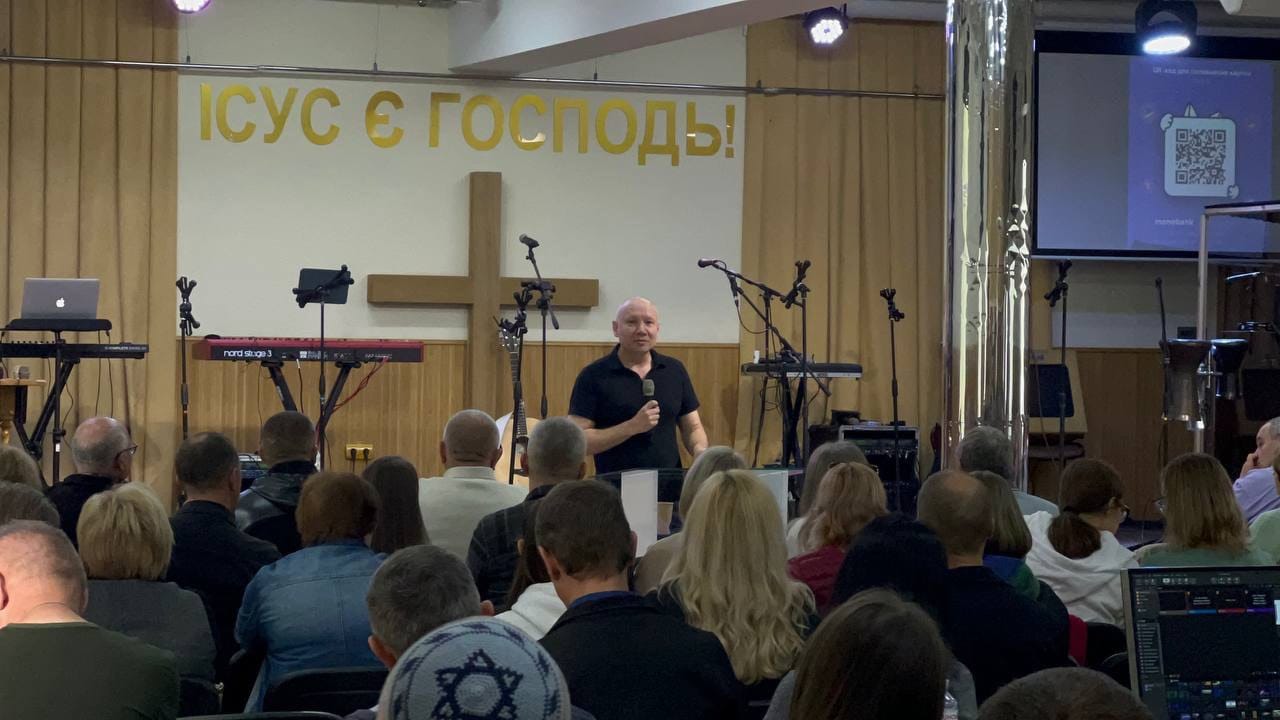Interview with Pastor Oleg Bodnar

Pastor Oleg has emerged as a symbol of hope for many Ukrainians suffering from the devastation of the Russian-Ukrainian war. From the very first days of the invasion, he and his church have worked tirelessly to provide humanitarian relief, making sure vital aid reaches the country’s most vulnerable communities. His journey has carried him to remote and war-torn regions of Ukraine, where he has delivered food, hygiene essentials, baking supplies, medicines, and even building materials to help families restore their homes. We thought you would enjoy learning more about the hard working people you support through the Armada Network. Your financial support has provided fuel and vehicle maintenance for multiple trips and projects over the past three years.
Please tell us about yourself and your church? How long have you been a pastor, and how did you come to this calling?
I became a pastor when I was 22 years old, back in 1998. After graduating from Bible college and a missionary school at St. James College, as well as a Bible school under the Emmanuel Mission (a branch of CBN in Ukraine led by Steve Weber), I was commissioned as a missionary and ordained into pastoral ministry in the city of Luhansk.
I served there in Eastern Ukraine until 2014. Alongside pastoral work, I also led a charitable foundation called “Mission in Ukraine,” which focused on social outreach.
When the war in the East began in 2014, I was forced to relocate to Kyiv. There, I joined the social department of a charismatic center and continued to serve, eventually becoming its director.
A few years later, around 2016–2017, we planted a new church in Kyiv called “Grace of God Church,” built primarily by internally displaced people from the East. Since then, we’ve been growing the church while continuing our social ministry.
On a personal note, I’m married to my wife Tanya, and we have a son, Serhiy, who is actively involved in our church as the worship leader.

What challenges did you face when the full-scale invasion began, and how did it affect your ministry?
The first challenge, of course, was survival—protecting my own life, my family, and our congregation. I needed to clearly understand what God wanted me to do in such a moment. My belief has always been that spiritual convictions must translate into practical action. Through prayer, I realized we needed to relocate to a relatively safer place to establish a base for both spiritual and social ministry.
We moved to Uzhhorod, where most of our church members were able to find shelter. With the help of friends, we rented houses and rooms so that people could escape danger. At the same time, we launched what we now call a “social hub,” working simultaneously in both Kyiv and Uzhhorod.
Another major challenge was safeguarding not only physical survival but also mental and spiritual health. Many churches in Kyiv closed, merged, or disappeared altogether during those chaotic early months. But because of our experience in 2014, we managed to preserve our congregation and grow the social hub into a powerful outreach center that continues to operate today.
The greatest test, however, has been learning to trust God daily—for provision, for resources, for strength. Pastoral ministry is unique in that sense: you rely completely on God while facing uncertainty at every step. Yet through it all, we have seen His faithfulness.
Can you tell us about your social work during the war?
Our work is broad and covers several directions.First, delivering humanitarian aid for various relief projects. Second, evacuating people from active war zones.
Third, medical support—working with hospitals, burn centers, and clinics by delivering medical equipment and supplies. Fourth, supporting smaller churches so they can grow, often by providing humanitarian assistance.
We also run a project called “Two Loaves,” where we bake bread ourselves and distribute it along with a copy of the New Testament. This way, people receive both physical and spiritual nourishment. Hundreds of thousands have already been touched by this project, including those living right on the frontlines.
We serve hot meals to the homeless, supply volunteer hubs with food, and provide ongoing support. Another direction is construction—repairing homes, installing water systems, heaters, and other equipment for families in need. We also maintain small settlements of displaced people, often with the help of volunteer groups.
Finally, we focus on rehabilitation: offering psychological support to those traumatized by the war, often through professional counselors. We also train volunteers in this work, expanding the culture of volunteerism in Ukraine.

What does humanitarian aid delivery look like in practice? What kind of items do you bring?
This is one of our central missions. We’ve established large hubs in Uzhhorod and Kyiv that receive aid from Europe and South Korea. From there, we distribute supplies to 50–100 smaller humanitarian centers across Ukraine.
We bring non-perishable food, pasta, canned goods, oil, grains, tea, coffee, medicines, medical equipment, hygiene items, clothing, footwear, and children’s gifts. Sometimes, shipments are project-specific—for example, flour for our bread-baking initiative.
What challenges do you face when transporting aid from abroad?
Even with years of experience, challenges remain. We always work within the legal framework of Ukraine and partner countries, carefully preparing all documents to move goods officially. But bureaucracy is a constant obstacle.
Rules for transporting aid frequently change—both in the EU and Ukraine—so we must constantly adapt, learn, and adjust. It’s time-consuming, but we are committed to ensuring Ukrainians get the help they need.

Evacuations seem especially dangerous. How do they work?
Yes, evacuation is one of the hardest and riskiest parts of our work. We evacuate people from nearly any hotspot where our teams or partners operate. Once evacuated, people are resettled in safer regions for two or three months, where they receive housing, food, and material support to help them adapt.
Some requests come directly from families in dangerous areas, others from relatives abroad asking us to rescue elderly parents. These missions must be carefully coordinated with police and the military. They are extremely dangerous, especially now with FPV drones targeting evacuation vehicles.
On average, in the Donetsk region alone, one team of three vehicles completes around 21 trips a week. Over a three-month period, that’s more than 60 missions in Donetsk and about a dozen in Zaporizhzhia. But our capacity is limited by funding, vehicles, and the constant need for repairs.
What are your greatest needs to expand this work?
Fuel is always the biggest need, followed by vehicle maintenance. Most of our cars are old and require constant repairs. Protective gear—helmets, body armor, and especially protective nets against drones—is also critical. Right now, 4–5 of our evacuation vehicles lack sufficient protection.
Finally, we need more people. Drivers and volunteers often work at their own expense. We would like to at least provide them with small stipends as a token of support.
What are your plans for the near future?
Our main goals remain the same: delivering aid to the frontlines, feeding people, baking bread, preaching the Gospel, and rescuing those trapped in danger zones.
We are also building a volunteer association—first among charismatic churches, but eventually across denominations. The vision is to create a strong network of partners who can join both humanitarian and spiritual projects.
Our project office in Kyiv continues to develop innovative approaches to social ministry and national rebuilding. It’s a unique combination of practical aid and spiritual calling.
How do you manage to balance pastoral ministry with humanitarian work?
It comes naturally, because I’ve been doing both since 2002, when I first became the director of a charitable foundation. I often describe myself as a “working pastor.” Like the Apostle Paul, who made tents to support his ministry, I integrate both roles as needed.
We have a strong team of assistants and volunteers, which makes the humanitarian side manageable. I focus on leadership and coordination, while also dedicating time to spiritual ministry, church planting, and mentoring pastors. Over the years, we’ve developed a system that allows us to do both effectively.
Tell us about your upcoming trips.
Right now, we are preparing two missions. The first is in the Donetsk region, where a team of several vehicles will evacuate people. The second is already underway in Zaporizhzhia, where the volunteers we work with are currently transporting families out of dangerous areas.
These missions require careful coordination—fuel, vehicles, volunteers, and prayer. Often, trips start in the middle of the night to reach evacuation sites at dawn. We are deeply grateful for every partner who provides fuel vouchers or financial support, because that is what makes each mission possible.
Pastor Oleg, thank you for your time, your service, and your extraordinary work.
Thank you as well—for your support, and for helping us bring hope to the people of Ukraine.
